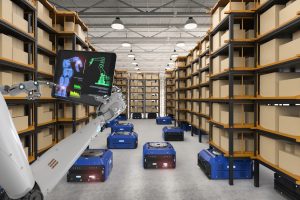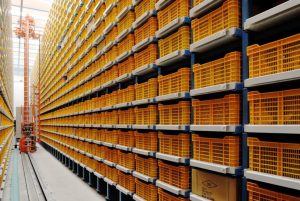Introduction
Automated sorters are used in warehousing to automate the process of sorting, organising and directing items to a designated location. There are many different types of sortation technology, and they can be used in a variety of ways, which will be outlined in this article.
If you are considering automation in your warehouse operations but are not sure where to start, or which technology is right for your business, then get in touch with our consulting team to discuss further.

What are Sorters Used For?
Automated sorters can be used to perform various tasks and different points of the process within the warehouse. They are highly accurate, efficient and can deal with a range of throughput requirements.
Inbound Sorting
Sorters can be used in receiving to sort items by SKU, size, weight or product category. This supports efficiency palletisation and directing to the next stage in the process. This may be as part of the main inbound process or even the returns process.
For example, items required for immediate despatch (cross dock) or specific storage areas can be easily split and moved to its intended target.
Order Fulfilment
Sorters can be used in receiving to sort items by SKU, size, weight or product category. This supports efficiency palletisation and directing to the next stage in the process. This may be as part of the main inbound process or even the returns process.
For example, items required for immediate despatch (cross dock) or specific storage areas can be easily split and moved to its intended target.
Shipping Processing
Sorters help prepare shipments by consolidating and sorting items into outbound containers or packages based on destination, carrier, or shipping method. This ensures accuracy in the shipping process and helps meet delivery deadlines.
For example, a warehouse that uses many different couriers can use a sorter to split parcels by courier and or service type and route.
How are Sorters Used?
There are three key steps to using a sorter, regardless of what they sorter is being used for.
Induction
Items need to be inducted into or onto the sorter from the previous process step, whether that is unloading from a container or bulk picking multiple orders. In some cases, this might be automated, using conveyors or AMRs, but in others it may involve a person placing an item onto a sorter.
Sortation
The sorter will automatically direct the item using high-capacity scanners to identify the item from a specific identifier, usually a barcode, and move it to the desired destination.
Processing
The item will need processing after it has been directed to the required location. This might mean that an item needs to be packed at packing station or palletised at a marshalling lane or placed into a cage or other container for onward shipment.
Types of Sorter
There are many different types of sorters and the right application for any operation will depend on the type of product being handled, the required speed of throughput, space constraints, scalability requirements and the integration with the existing infrastructure and processes.
Type | Description |
|---|---|
Cross-Belt Sorters | Cross-belt sorters use a series of belts running perpendicular to the direction of travel to carry items. Items are placed on the belts and diverted to the appropriate chute or conveyor based on their destination. These sorters are versatile and can handle a wide range of item sizes and shapes. |
Sliding Shoe Sorters | Sliding shoe sorters use a series of slats or shoes that slide diagonally across the sorter’s surface. As items move along the sorter, the shoes can push them off onto the appropriate conveyor or chute based on predetermined criteria such as destination or order sequence. |
Tilt-Tray Sorters | Tilt-tray sorters consist of trays that tilt to divert items into the desired chute or conveyor. Items are loaded onto the trays and transported along the sorter. When a tray reaches its designated destination, it tilts, allowing the item to slide off into the appropriate location. |
Pusher/Sweeper Sorters | Pusher sorters use mechanical pushers or sweepers, mounted above the sort locations, to push items off the sorter onto the correct conveyor or chute. As items move along the sorter, sensors detect their destination and trigger the corresponding pusher to divert them accordingly. |
Pop-up Wheel Sorters | Pop-up wheel sorters utilise a series of wheels that pop up to guide items into the desired direction. Items are conveyed along the sorter, and when they reach the appropriate divert point, the wheels rise to direct them onto the correct path. |
Vertical Sorters | Vertical sorters commonly work similarly to Cross Belts or Tilt Trays but rather than being shaped in a circle, it loops back underneath itself to save space. This is useful in operations with space constraints or a limited number of destinations. |
Linear Sorters | These sorters use a straight conveyor system with diverters or chutes placed along the length of the conveyor. Items are sorted based on predetermined criteria, such as destination or product type, and directed to the appropriate chute for further processing or shipping. |
Bomb Bay Sorters | Bomb bay sorters feature trays that can drop vertically from the main conveyor to release items into designated bins or chutes below. This type of sorter is often used for high-speed sorting of small items. |
Narrow Belt Sorter | Uses narrow belts to move items off the conveyor either at 30 or 90 degrees. This is a typically used for sorting cases and medium sized or weight items. |
Swivel Wheel Sorter | Uses wheels that swivel to roll a particular item off the conveyor at the correct location. |
Goods-on-Hanger | Goods on Hanger sorters handle apparel items on hangers. These clip on a overhead rail conveyor and are split into various destinations. Hanging items can be handled as individual units or on ‘carriers’ (which hold multiple items at a time. |
Pocket | Pocket sorters use similar technology to Goods on Hanger sorters, however, each item is placed into a pocket, allowing the handling of a wide range of product types, including hanging, flat and boxed items. |
AMR | Autonomous Mobile Robots move around a grid, carrying items and tipping them into containers or chutes. |
Robotic Arm | This type of sorter is presented with items which it then picks up and places within receptacles which are placed around the arm. This can either be a pick wall or a circular wall around the arm. Items need to have characteristics that allow them to be picked up by the robotic arm, commonly using suction or grippers. |
Put Wall | Small sorter that that works with lifts and shuttles moving to the location to drop items into totes on a put wall. Once the order is complete this would be removed and take to a pack bench. This is commonly used to sort multi-unit ecommerce items into orders for packing. |
A-Frames | Normally used by pharmaceutical environment with very small boxes. Items are stacked into lanes on the frame and are dropped into the target container running underneath the A-shaped frame. The target may be a tote, carton or a section of conveyor that drops into a container at the end. |

Selecting the Right Sorter
There are several factors to consider when choosing the right sorter for a warehouse operation.
Throughput Requirements
Sorters can be sensitive to the number of items per hour that it is required to sort. Some sorter types, such as cross-belt sorters or tilt tray sorters, are known for their high throughput capabilities and are suitable for warehouses with large sorting demands. Robotic solutions, amongst others, prove more cost effective and space efficient at lower volumes.
Item Characteristics
The product type is a significant factor in the appropriateness of a sorter. For example, sliding shoe sorters are versatile and can handle a wide range of item shapes and sizes, while pop-up wheel sorters may be better for smaller items.
If you have hanging garments and boxed stock a hanging garment sorter that also uses pockets may make the most sense. Fragile items are not suited to a Bombay type sorter and would need to be tested against the various chutes. Sorters are generally divided into case and items sorter, whilst some hybrid options can do both.
Space Constraints
Some sorter applications are more space hungry than others. Linear sorters, for instance, typically require more linear space compared to circular sorter types like tilt tray or cross-belt sorters. If you have small items going to a large number of destinations a robotic arm sorter may work well.
Accuracy and Reliability
Some sorter types offer a higher rate of accuracy or better reliability in handling fragile or irregularly shaped items. It is a good idea to use test products on demo installations, if possible, in advance of making a firm decision. Warehouse automation offers greater accuracy than people-based processes, however, there will inevitably be a minor fraction of errors.
Integration with Existing Systems
Sorters can integrate with the warehouse’s existing infrastructure, including conveyor systems, material handling equipment, and control software. Compatibility and ease of integration can impact implementation time and costs.
Scalability
Certain sorter solutions are better at scaling up or down to accommodate changing operational needs over time. Scalability is essential for future-proofing the warehouse and ensuring that the sorter can adapt to growth or changes in business requirements. Circular sorters are more difficult to extend while AMR type sorters allow you quickly add more capacity.
There is generally a multiple cross over points where one type of sorter becomes more appropriate than another and this should be considered by assessing an operations future, as well as the immediate requirements.
Cost Considerations
Total cost of ownership should be considered when assessing any type of automation solution. Compare the initial capex as well as the opex (maintenance, downtime, efficiency) for different sorter types.
While some sorter types may have higher upfront costs, they may offer long-term benefits in terms of efficiency, reliability, and reduced operational costs. Generally, a five-to-ten-year cost analysis to see which type of sorter will have the best long-term benefit is advised.
Where Can This Technology be Used?
Automated sorters can be used in any warehouse with a reasonable level of throughput that receives or despatches product; or picks orders that comprise of multiple pick lines.
The Postal and Parcel Delivery sector is one of the primary users of this technology to improve the speed and accuracy of significant volumes of mail and parcels being shipped nationwide and internationally. The high volumes typically require cross-belt sorters or similar.
The retail and ecommerce sector is another common user of sorters, whether used for order fulfilment in the form of pocket sorters for online customers, circular sorters for store replenishment or a range of technology for the marshalling and despatch of parcels. Despatch sorters can be particularly effective at sorting parcels by courier or delivery method in the small window between order cut off and despatch.
Sorters can work well with other solutions including manual picking systems or automated storage and retrieval systems (ASRS). A sorter has the potential to take a significant amount of horsepower out of an ASRS by taking on the order splitting role, allowing the ASRS to reduce the number of order lines and equipment required to support this.
Pros and Cons
Automated warehouse sortation technology can increase the efficiency and accuracy of an operation compared with manual processes. This allows for savings in labour costs, improved operational resilience and lower errors.
The speed and accuracy as a despatch sorter also enables businesses to enhance the customer proposition with greater flexibility for customers through later order cut-offs. It also enables sortation to a wider range of carriers that may either offer better customer service or lower shipping costs on certain lanes.
As with any automation, there are downsides. Many sorters carry a significant upfront investment in technology, infrastructure and training. Once deployed, they increase the complexity of an operation and require regular maintenance and technical support to drive uptime, which adds to ongoing costs.
Automation can reduce flexibility and if the equipment malfunctions, it can result in disruption to service. It becomes much harder to setup a manual workaround, particularly if there are no longer enough people onsite to support a manual workaround.
A robust business case should determine whether the pros of automated sortation outweigh the cons and offer an attractive and feasible return on investment. Disaster recovery solutions should be put in place for any operation introducing a single point of failure.
Comparable Technologies
There are very few alternatives other than manual sortation for sorting items at inbound or despatch, however, other options do exist where sorters are used as part of the picking process.
Manual solutions including Pick-to-Light or Put-to-Light systems use lights and displays to guide people to sort items into specific locations. This increases efficiency compared to manual order picking and reduces the level of capex required compared to automated sortation solutions.
The other option is to use an ASRS to perform the entire picking process. The robots or shuttles carry out the sequencing by bringing the products to a Goods-to-Person pick station in the required order. This requires a bigger throughput capacity, and therefore capex, in the ASRS but can reduce double handling.

Summary
Automated sortation is an important technology within warehousing for businesses with large enough volumes to generate a return on investment. It reduces labour costs, increases accuracy and fulfilment speed as well as enabling other customer-friendly measures. For this reason, sorters are frequently found in the warehouses of parcel carriers and the retail or ecommerce sector.
Investing in automation can involve significant capital expenditure but a full business case will determine how attractive the return on investment is. There is a wide range of sortation technology on the market, and it is critical to assess the throughput requirements, product types and scalability to determine the most appropriate equipment for each operation.
BoxLogic has a wealth of experience in Warehouse Automation projects for a variety of cross-sector clients. From identifying suitable types of automation, analysing expected benefits and ROI timescales, through to shortlisting and suggesting vendors. Our independence means that we identify the most appropriate solution for you. If there is no case for automation, we will recommend a manual solution and help you design it.
BoxLogic is well positioned to assist you with your next Warehouse Automation project. Contact us to discuss your project today.



